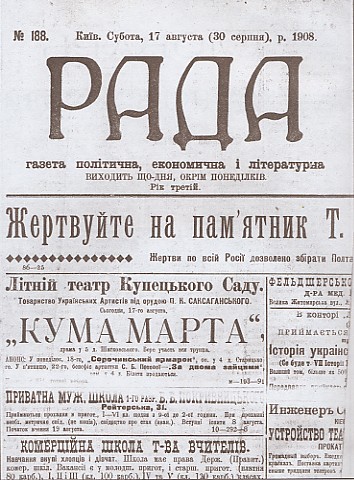Rada (Kyiv)
Rada (Kyiv) («Рада»; Council). A political and cultural newspaper published in Kyiv from September 1906 to August 1914. In that period it was the only Ukrainian-language daily in tsarist-ruled Ukraine. Initially an organ of the Ukrainian Democratic Radical party, Rada succeeded the banned daily Hromads’ka dumka. It was published by Borys Hrinchenko and, from 1907, by Yevhen Chykalenko, who provided most of the funding. Some capital investment came from Vasyl Symyrenko, Volodymyr M. Leontovych, Petro Stebnytsky, Mykhailo Komarov, Pavlo Pelekhin, and Leonid Zhebunev. From 1908, although officially nonpartisan, Rada reflected the political views of the Society of Ukrainian Progressives, to which Chykalenko and many of the contributors belonged. Its chief editors were Fedir Matushevsky, Metodii Pavlovsky (1907–13), and Andrii Nikovsky. The editorial secretaries were Symon Petliura, Vasyl Koroliv-Stary, and P. Sabaldyr (Maiorsky). From 1907 the paper also had several section editors: Dmytro Doroshenko (to 1909, developments in Ukraine), Liudmyla Starytska-Cherniakhivska (developments in the Russian Empire), Mykhailo Lozynsky (foreign developments), Hryhorii Sherstiuk (education), Maksym Hekhter (socioeconomic affairs), and Bohdan Yaroshevsky and occasionally Viacheslav Lypynsky (developments in Poland). Its prominent contributors were Hrytsko Chuprynka, Pavlo Chyzhevsky, Vasyl Domanytsky, Volodymyr Doroshenko, Svitozor Drahomanov, Volodymyr Durdukivsky, Ivan Dzhydzhora, Ivan Franko, Mariia Hrinchenko, Mykhailo Hrushevsky, Pylyp Kapelhorodsky, Hryhorii Kovalenko, Mykhailo Kotsiubynsky, Modest Levytsky, Oleksander Lototsky, Ivan Lypa, Yakiv Mamontov, Oleksander Oles, Lev Padalka, Viktor Pisniachevsky, Mykola Porsh, Viacheslav Prokopovych, Oleksander Rusov, Volodymyr Samiilenko, Serhii Shelukhyn, Kostiantyn Shyrotsky, Volodymyr Stepankivsky, Hryhorii Stepura, Mykola Trotsky, Yurii Tyshchenko, Stepan Vasylchenko, Mykola Vorony, Volodymyr Vynnychenko, Andrii Yakovliv, and Andrii Zhuk. By providing news from all the Ukrainian lands and responding to all political and cultural developments, Rada played a key role in the crystallization of a nationally conscious Ukrainian intelligentsia. Because of persistent tsarist interference and persecution as well as frequent fines and confiscations of issues, it was able to print only 3,000 to 5,000 copies and had no more than 2,000 subscribers. Three days after the Russian Empire entered the First World War, the paper was shut down. It was revived after the February Revolution of 1917 under the title Nova rada (Kyiv).
Vadym Pavlovsky
[This article originally appeared in the Encyclopedia of Ukraine, vol. 4 (1993).]
.jpg)

.jpg)